- Know about
Shilahar Dynasty & Yadavas of Devgiri near Aurangabad to know who ruled
parts of Maharashtra, Goa etc. Part 2 covers Rashtrakutas and Chalukyas.
The early medieval period in Deccan saw dynasties
like Chalukya, being replaced by Rashtrakuta. Rashtrakutas were then displaced
by later Chalukyas, also known as Western Chalukyas to differentiate them from
the Eastern Chalukyas of Vengi. The later Chalukyas were dethroned by Yadavas
who ruled from Narmada to Tungabhadra. These dynasties ruled over vast areas of
current day Maharashtra, Karnataka, Goa, parts of Gujarat, Andhra Pradesh and Telangana.
Here are details of individual dynasties that ruled parts of modern day Maharashtra, Madhya Pradesh, Gujarat and Telangana. This is part 1. To know of Administrative Divisions in medieval Deccan click on PDF
SHILAHAR DYNASTY
There were three separate branches of Shilahar
dynasty in Maharashtra namely Northern, Southern, and later Shilaharas. All of
them claim descent from Jimutvahan (son of Vidyadhar King Jimutketu) who waited
on sacrificial stone and was eaten by Garud (of Shri Vishnu) in place of Shankhachud serpent. However, on
learning the reality, he was brought back to life by Garud, thus gaining the
title Shilahar (Shila-Sacrificial stone, Ahar-Garudas food).
The original place of Shilahars was Tagar,
a prosperous town described by Greek historians Ptolemy and Periplus (now Ter, Dharashiv district of Maharashtra)
as many of the kings had the title Tagarpuradishvar
(lord of the Tagar).
1. Northern Branch of Shilahars (ruled mainly Northern Konkan. 800-1265 A.D)
Summary - This branch of Shilahars was called northern
by historians as it ruled the area of Northern Konkan including portions of
southern Gujarat, Pune and certain areas of Khandesh in current Maharashtra.
They ruled nominally as a feudatory of Rashtrakutas and later Chalukyas but
mostly they were independent in their internal rule. At the height of their
expansion, they also ruled southern Konkan including Goa. They ruled from 800
to 1265CE i.e., close to 465 years.
To know names of Shilahara kings 800-1265
A.D. click on PDF For details read on.
Kapardin I, the founder of this branch was
a feudatory of Rashtrakuta King Govind-III and helped him capture north Konkan
from the Chalukyas. Due to his valor, Govind III appointed Kapardin-I as his Viceroy.
Konkan area controlled by him was known as Kapardi/Kavadi Dwip. Shristhanak
(Thane near Mumbai) was the capital.
From Jhanjha to Chhadvaideva, there seems
to be a decline of Shilahars as Sanjan and nearby areas was given by
Rashtrakuta King Krishna II to an Arab immigrant named Mahmud (Sanskritised
Madhumati) but after the decline of Rashtrakutas, Shilahar king Aparajita
attacked and destroyed Sabuktgin (Sanskritised Sugatipa). During his reign
Shilahars controlled territory Western coast, from Lata (Southern Gujarat) to
Chandrapur (Chandor, Goa) defeating Kadamba king Guhalladeva-I, and from Pune
up to Seundesh (now, Khandesh area of Maharashtra).
He held royal titles like ‘Paschimsamudradhipati’ (Lord of the Western Sea). However, his attempt to gain full independence was crushed, for the time being, by Tailapa II who reinstated Chalukya rule after defeating Indra IV of Rashtrakutas. According to the Sahasbhimvijay
of Ranna (Rajkavi of Tailapa II), Prince Satyashraya sacked Thana, but
Aparajita I, with the help of his naval fleet,
was able to escape (981-982CE) and within ten years regained his independence.
During the reign of his son Chittaraja,
Shashthadev II (son of Guhalladeva-I, Goa Kadamba) who had lost a major portion
of his kingdom to Shilahars, attacked and defeated Chittaraja. For the time
being Shilahars became feudatory of Kadambas in place of Chalukyas.
After the death of Chittaraja, his brother Nagarjuna became king. However, he soon faced an invasion from Someshvara I (Chalukya), who wanted to reinstate the control of Chalukyas over the Konkan. Nagarjuna was killed in 1045 and as per the treaty, Mummuniraja (youngest brother of Chittaraja) was placed on Shilahar throne as Anantdev I (Nagarjuna’s son) was minor.
A war of succession between the son of
Mummuniraja and Anantdev I was described as a dayadvyasan in contemporary records. Jayakeshi I (Goa Kadamaba)
helped the son of Mummuniraja along with some Arab-Muslim levies but Anantdev-I
fought valorously, defeated them and took the family title of ‘Paschimsamudradhipati’
and ‘Nishankalankeshwar’ (defeated Lankesh i.e., Jayakeshi I).
The feud between Shilahars and Kadamabs continued and Anantdev I was killed in the battle with Jayakeshi II (grandson of Jayakeshi I) in 1124-25CE. However, Kadamba’s rule lasted only a couple of years as a combined force of Aparaditya I (Anantdev I’s son) and Vijayaditya of Kolhapur Shilahar defeated Kadambas and regained Konkan in 1127 CE. He divided his kingdom between elder son Haripaladeva (ruling from Thane) and Vikramaditya (ruling from Panhale, 7km from Lanja, Ratnagiri district in Maharashtra).
Mallikarjuna (Haripaladeva’s son) had to face a sudden invasion of Kumarpala (Anhilwada Chaulukyas/Solankis) and was killed in battle near Thane in 1170CE. However, his successor Aparaditya II soon regained independence but the power of Shilahars was waning.
Yadavas become independent by replacing Chalukyas in the Deccan. Keshidev II, (Aparaditya II’s son) was defeated by Kholeshwar (Commander in Chief of Yadava Singhan II).
The final blow to the last Shilahar king Someshvara was given by Mahadev (Singhana II’s younger son). Shristhanak was sacked again by Yadava forces and the attempt of Someshvara to flee with the help of navy failed when his ship was damaged and he drowned in the land-naval engagement fought at Eksar/Borivali (Mumbai) in 1265CE. The whole Konkan was now controlled by Yadavas of Devgiri.
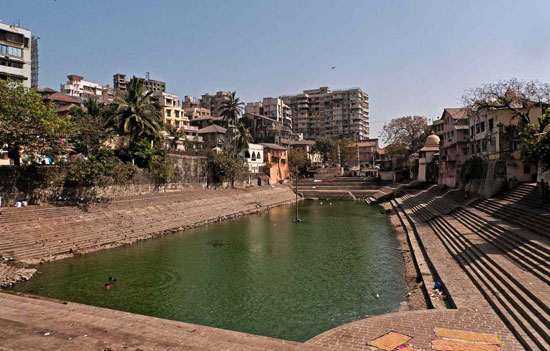 Banganga Tank in Mumbai made by Shilahar king.
Banganga Tank in Mumbai made by Shilahar king.
2. Southern Branch of Shilahars (ruled mainly South Konkan etc. 765-1024 A.D.)
Summary - This branch of Shilahars was
called southern by historians as it ruled the area of southern Konkan including
parts of current Goa state. They were feudatories of Rashtrakutas. This branch
of Shilahar kings ruled from 765CE to 1024CE i.e., close to 260 years.
To know names of Shilahara kings 765-1024
A.D. click on PDF For details read on.
Sanaphulla, the founder of this branch was
a feudatory of Rashtrakuta King Krishna-I. His capital was Chandrapur (Chandor)
in Sinhaldesh (old name of Goa) but his son Dhammiyar shifted the capital to
Balipattan (Kharepatan, Maharashtra).
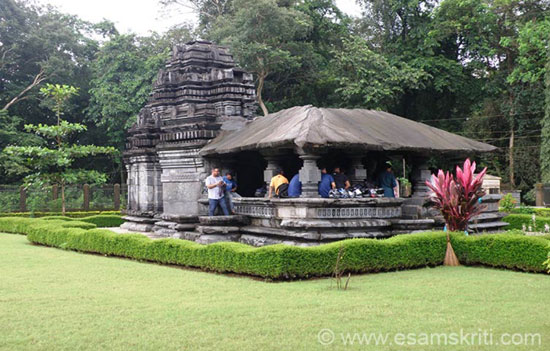 Tamdi Surla Shiv Mandir dated 13th century is credited to the Kadamba dynasty.
Tamdi Surla Shiv Mandir dated 13th century is credited to the Kadamba dynasty. Aiyaparaja (Dhammiyar’s son) was able to recapture Chandrapur from Chalukyas and to commemorate the win he consecrated himself with coconut water. For the next 130 years (from 830CE to 960CE), southern Konkan including Goa was under the Shilahar rule, but Bhima (8th Shilahar king) mistakenly helped
Shashthdeva I (Goa Kadambas founder) to gain prominence.
After losing Chandrapur to Kadambas under Nagvarma (Shashthdeva I’s son), Shilahar king Avasar III or Ajatshatru ruled from Kharepatan. By 982CE, the Chalukya’s under Tailapa-II had replaced Rashtrakuta’s, but Avasar III has not accepted his suzerainty. Hence the kingdom came under constant Chalukya attacks, from Satyashraya (who had also attacked Aparajita I of North Shilahars) to Vikramaditya V.
The final blow to southern Shilahars was
received during the reign of Rattaraja by Chalukya king Jayasimha II who
defeated and annexed their territory in 1024CE.
 Temple at Ambernath, near Mumbai made by Shilahar king.
Temple at Ambernath, near Mumbai made by Shilahar king.
3. Kolhapur branch Shilahars (ruled Kolhapur, Miraj, Karhad districts 940-1212)
Summary- This branch was called later Shilahars by
historians as it emerged during the latter part of Rashtrakuta rule. They were
also called Kolhapur Shilahars as their capital was Kolhapur. They ruled the
area of Kolhapur, Satara, Sangli, and southern Konkan including portions of the
current Goa state. This branch of Shilahar kings ruled from 940CE to 1212CE
i.e., close to 275 years.
To know names of Shilahara kings 940-1212
A.D. click on PDF For details read on.
This branch came into prominence during
the turbulent period of Rashtrakuta-Chalukya wars. Jatiga I, founder of
Kolhapur branch was a feudatory of Rashtrakutas. His nephew Permanadi had tried
to resurrect the fading Rashtrakuta power but in vain.
But his successors like Jatiga-II and Gonka & Guhala I (Jatiga II’s sons) backed Chalukyas, especially Guhala I who became a close friend of Satyashraya (Chaluka king Tailapa II’s son) and accompanied him in various campaigns. Jatiga II captured Panhala and his title was Pannaldurgadrisinh
(Valorous like lion residing at Panhala). He helped Jaysimha II (Chalukya) in
his campaign against the southern Shilahars and received Karhat (Karad),
Mirinjdesh (Miraj). Kundidesh (Belgavi area) and southern Konkan.
Jatiga II appointed his sons Gonka,
Guhala-I, Kirtiraj and Chandraditya as a regent in these areas. After Gonka,
his son Marsinh became king whose daughter Chandralekha married Chalukya king Vikramaditya VI.
Bilhana (Kashmiri origin court poet of Vikramaditya VI) in his ‘Vikramankdevcharitra’ had described beauty of Chandralekha (also called Nrityavidyadhari and Abhinav
Sarasvati- i.e., expert in classical dance and other art forms) and her marriage to Vikramaditya-VI. The legends of Chandralekha’s beauty had reached as far as Kashmir, as Kalhana’s Rajatarangini also mentions that when Harsha (Lohara-Kashmir) saw the portrait of Chandralekha he decided to attack Chalukyas to capture her. But like his various fantasies this pipe dream, on which Kalhana has scoffed, never actually materialized.
Since Marsinh gave Karhat in dowry to Vikramaditya VI, he had to shift capital to Panhala. He had five sons out of which Guhala II, Ballala, and Gandaraditya became kings in succession, out of which reign of Gandaraditya was most famous. He held titles like ‘Tribhuvantilak’ and ‘Mahalakshmilabhdha-Varprasad’ (ruling by grace of Devi Mahalakshmi of Kolhapur).
Also he constructed a large tank called
Gandasamudra (son of Ganda) in Miraj district, placed on its margin images of
Buddha, Shiva, Jina and assigned land for maintenance of each. 2 Pg. 184
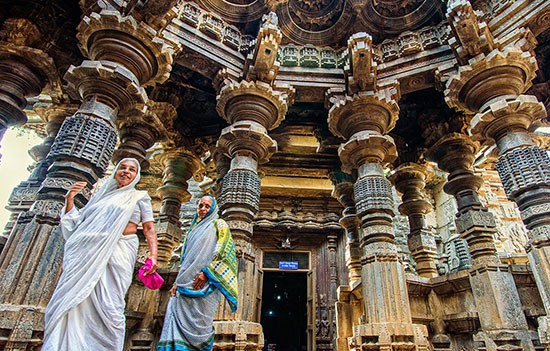 Amazing Khidrapur temple near Kolhapur made by Gandaraditya. Pic by Saibal.
Amazing Khidrapur temple near Kolhapur made by Gandaraditya. Pic by Saibal.
Gandaraditya was a great patron of
temples, the construction of Kopeshwar temple at Khidrapur started during his
reign.
To see album of Khidrapur
Shiv Mandir
He also started refortification of Panhala
which was completed by his grandson
Bhoja-II. Vijayaditya, his son helped Anantdev I and was instrumental in the
combined Shilahar victory over Jayakeshi II (Kadamba).
Vijayaditya was very ambitious and he helped Bijjala II (southern Kalachuri) to defeat Tailapa III thereby accelerating the breakdown of Chalukyas. Vijayaditya then helped Parmadideva (Jayakeshi II’s son) in defeating Bijjala II in the battle near Shirol weakening him. The defeat of Tailapa-III and Bijjala-II weakened Chalukyas and southern Kalachuri’s respectively and Vijayaditya now declared his complete independence from Chalukya domination.
This change is reflected in the titles of Vijayaditya’s son Bhoja II who assumed titles like ‘Rajadhiraj’ (king of
kings) and Paschim-Chakravarti (Emperor of West).
However, during this period, Yadavas under
Bhillam V had also started to assert their sovereignty and his grandson Singhan
II attacked Shilharas and defeated them in battle of Khidrapur. Bhoja-II was
besieged on Panhala and had to surrender himself. He was jailed at Panhala and
with his death within a year the Kolhapur Shilahars ceased to exist.
Shilaharas were Shivbhakts and major
temples like Kopeshwar (Gandaraditya-Bhoja-II), Ambernath
(Chittaraja-Mummuniraj), Walkeshwar were built during their reign.
They were patrons of art and books such as Udaysundari Katha (by Sodhal), Apararktika
(commentary on Yadnyawalkyasmriti by
king Aparaditya I), Neminathpurana
(by Karnaparya), Shabdarnavchandrika
(commentary on Jain Vyakarana by Someshvara) are some of the notable literary
works during their reigns.
They carried the Suvarna-Garuda-Dhvaja
(banner of a golden Garuda).
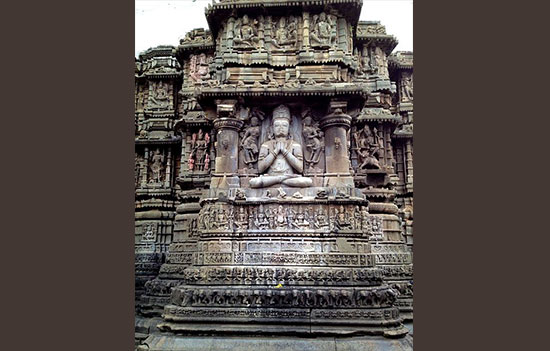 Aundha Nagnath Temple, Maharashtra was built by the Yadavas. Credit Vijay Chenupathi
Aundha Nagnath Temple, Maharashtra was built by the Yadavas. Credit Vijay Chenupathi
SEVUNA
YADAVAS (860-1318 A.D.)
Summary - The Sevuna Yadavas were acting as feudatories of Rashtrakutas from
860CE to 982CE. After Chalukyas dethroned Rashtrakutas, Yadavas became
feudatory of Chalukyas from 982CE to 1180CE. In 1180s, Yadavas declared
independence from Chalukyas and started to rule independently. At the height,
their rule extended from southern Gujarat, Maharashtra, parts of northern
Karnataka, and western Andhra, parts of Madhya Pradesh and Uttar Pradesh.
To know names of Sevuna Yadava kings
860-1318 A.D. click on PDF For
details read on.
The predecessors of the Yadavas ruled over
an area comprising of Khandesh, Nasik and Ahmednagar districts of Bombay State,
as vassals of the Rashtrakutas and Chalukyas of Kalyana, for more than three
hundred years. 2 Pg. 185
The dynasty claims descent from Yaduvansh. ‘Dridhprahar’ (founder) started as a feudatory of Rashtrakuta and founded Chandradityapur (Chandwad, Maharashtra) around 860CE. His son, Sevuna founded Shrinagar (Sinnar, Maharashtra) as his capital. The successors of Sevuna are referred as the Sevunas. His great-grandson Vaddig I participated valorously in the military campaigns of Rashtrakuta king Krishna III especially in defeating Pratiharas (Kannauj). As a reward, he was married to Krishna’s sister which increased his fortunes.
However, during the turmoil of Rashtrakuta-Parmara wars, when Rashtrakuata power was considerably weakened by the defeat and sack of Manykheta by Siyaka (Parmar), Bhillam II (Vaddig I’s grandson) supported Tailapa II, (Chalukya feudatory of Rashtrakutas) against Karka II (973BC) and later Indra IV, thus ending Rashtrakuta dynasty. He also helped Tailapa II to consolidate his rule, during the campaign against Munja (Parmar), Siyaka’s successor.
Vesugi I (Bhillam II’s son), helped Barapa, to conquer Lata (Southern Gujarat) region, which was the start of Lata-Chalukya branch. Their relations were cemented when Barapa married his daughter Nayaldevi with him. Similarly, Bhillama III (Vesugi I’s son) married a sister of Chalukya king Someshvara-I. Thus, Yadavs became the most prominent feudatory of Chalukyas.
For the next fifty years, the details are
obscure but Seunchandra II and his sons Paramdev & Singhana I restored the
fortunes by helping Vikramaditya-VI gain the Chalukya throne from his brother Someshvar
II and rising as a Mahamandaleshwar. Singhana I helped Vikramaditya VI
to obtain a Karpura (White) elephant from Orissa to complete his karpura-vrata. Amarmalugi (Singhana I’ grandson) defeated Bijjala II (southern Kalachuri) in 1150s when he was trying to become independent from the Chalukyas.
However, as mentioned earlier during the reign of Tailapa III, his defeat first by Prola II (Kakatiya feudatory) and then by a combined force of Bijjala II & Vijayaditya (Kalachuri and Kolhapur Shilahar), resulted in the disintegration of Chalukyas. Tailapa III had to flee to Annigeri when Bijjala II captured Chalukya capital Kalyani (Basavkalyan). Bijjala II assumed the royal title of ‘Shriprithivallabh’ and tried to revive Kalchuri rule. But, in the battle of Shirol, Vijayaditya (Kolhapur Shilahar) and Parmadideva (Kadamba) defeated Bijjala-II.
(Note that Bijjala II is from Southern Kalachuri dynasty who were feudatories of Rashtrakuta and later Chalukyas. Southern Kalachuri’s are from the sister branch of Kalachuri of Tripuri (Tewar, Madhya Pradesh). They built temples at Amarkantak.)
Someshvara IV, the successor of Tailapa III
tried to revive Chalukyas but by this time his feudatories Bhillam V (Yadav),
Veer Ballala II (Hoyasala) & Prataprudra-I (Kakatiya) had become too
powerful to contain. Someshvara IV was decisively defeated by Veera Ballala-II
at the Battle of Krishna-Venna thus ending the Chalukya rule.
In this period, Bhillam V dropped feudal
status & emerged as an independent king. He
also founded Devgiri, the capital of Yadavas. He took control of the capital Kalyani from Narasimha I (father of Veer Ballala II). Jaitrapal (Bhillam V’s son) helped Ganapatideva (Prataprudra I’s son) defeat his uncle Mahadeva to regain Kakatiya throne. Jaitrapal was a patron of arts, Lakshmidhar (son of renowned astrologer Bhaskaracharya),
as well as Mukundraj (author of Viveksindhu), were in his court.
His son Singhan II (1210-47CE) was more
ambitious. He was an expert elephant rider, an art taught by Janardan Pandit. In
the battle against Paramara king Arjunavarman, he
used trained elephant corps to defeat Paramaras. He also defeated Bhoja II
of Kolhapur Shilahars in 1212CE, ending Shilahara rule over Southern Konkan
& Kolhapur, and Jaya Raja (Rattas of Saundatti). His first expedition on
Anahilwada was repulsed by Vaghelas (Lavanaprasad & Virdhaval) but in the second
expedition, commanded by Kholeshwar in 1218-19CE, Yadavas were able to defeat
them thereby extending their rule over southern Gujarat. In the third
expedition, Virdhaval was killed (1238CE) by Yadavas and Visaldeva become
Vaghela king.
Singhana II now took royal titles like ‘Prithvi-vallabh’ (husband i.e., conqueror of the earth), & ‘Dwarawati-pura-varadhishvar’ (Lord of Dwaraka) to show his connection with Yadu clan of Shri Krishna. Shikhar Shingnapur temple was built by him (Shingnapur
from his name Singhan-II).
As Singhana II’s sons, Ram and Jaitrapal-II, predeceased him the Yadav throne went to Krishna, his grandson. Krishna first defeated Visaldev, his son Ram (Vaghelas) and Jaitugideva of Parmar dynasty. Jaitugi had to move his capital from Dhar to Mandu due to repeated invasions of his kingdom by Yadava, Vaghela’s & Balban (Delhi Sultan). Hemadri cryptically wrote about Krishna’s death as ‘after all the kings on the earth were conquered, Krishna went to capture Indra’s throne’. In one of his inscriptions, he was titled Vedoddhra (upholder of the Vedas).
After Krishna, his younger brother Mahadev (1260-70CE) ascended Yadava throne as Krishna’s son Ramchandra was a minor. Mahadev further expanded Yadava kingdom. In the battle of Eksar/Borivali, he defeated Shilahar King Someshwar (Thane) with the help of a trained elephant corps-navy combination and was able to capture Konkan coast. He took title of ‘Praudh-Pratap-Chakravarti’.
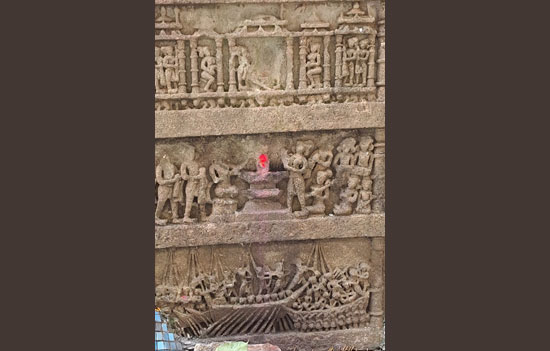 Virgal (Hero stones) depicting the battle of Eksar (Borivali, Mumbai) between Shilahar king Someshwar & Yadav king Mahadevrai in 1265CE. The battle was fought on land as well as at sea. Pic credit author.
Virgal (Hero stones) depicting the battle of Eksar (Borivali, Mumbai) between Shilahar king Someshwar & Yadav king Mahadevrai in 1265CE. The battle was fought on land as well as at sea. Pic credit author.
After the death of Mahadev, his son Amana grabbed the throne but since most nobles including Tikama (C-in-C) and Hemadri (Pradhan) supported Ramchandra (Krishna’s son), he was able to dethrone Amana in 1271CE. Ramchandra started his northward expansion by attacking Vaghelas and Parmaras. A grant given at Thane in 1272CE describes him as ‘Gurjar-kunjar-dalan-kanthirav’
(taming the elephant of Gujarat (Vaghelas)), Malav-Pradip-Samana-Anila (wind
extinguishing the flame of Malava {Paramara}) (EI-13, 202).
According to Purushottampuri inscription, Ramchandra briefly held Kashi (probably between 1286-90CE) and built a temple of Sharangdhar (Vishnu) with gold (EI25-211). However, his northward expansion and contest for Malwa attracted attention of Khilji’s who had dethroned Mamluks from Delhi. Ali Gurshasp, a nephew of Sultan Jalaluddin was waiting for an opportunity to overthrow his uncle. When he heard about the legendary wealth of kingdoms like the Yadavas & Kakatiyas during his 1293 raid on Bhilsa, he drew up a plan to attack Devgiri, loot the wealth, and use it to bribe Delhi nobles for his accession as Sultan.
He kept this plan secret even from his uncle and waited for a suitable opportunity. In late 1295CE, after getting intelligence that Yadava army was out on campaign, his force marched from Kara (Jehanabadand) & suddenly attacked Devgiri. The hastily assembled army by King Ramchandra was defeated and took sanctuary in fort, leaving the city in Khilji’s hands which he thoroughly sacked.
As Khilji’s army was not carrying heavy siege materials, it was difficult to capture the fort. However, scarcity of provisions coupled with a rumor that the besieging army was only a vanguard of much larger Sultanate force prompted Ramachandra to sue for peace. Meanwhile, Prince Singhana III returned and a bitter battle was fought which Yadavas lost.
Ali now demanded more tribute and the
annual revenue of Achalapur (Elichpur, Maharashtra) which Ramachandra had to
comply with. Also, he had to marry his daughter Jaitrapali (Chhitai) to Ali. Taking
advantage of this defeat Prataprudra (Kakatiyas) annexed Anantpur and Raichur.
Similarly, Veera Ballala-III (Hoysala) annexed areas like Banvasi in Karnataka
from Yadavas.
With the wealth of Devgiri, Ali recruited more troops and bribed Delhi nobles in
his support and with their help was able to assassinate Jalaluddin. He now became Sultan Allauddin Khilji.
In 1299CE Allauddin defeated Vaghelas, sacked Anahilwada, and captured Rai Karna’s wife Kamaldevi. SinghanavIII prompted his father Ramchandra to give sanctuary Rai Karna. He provided Karna with monetary and possibly military help to regain some of his kingdom as Karna was ruling parts of Gujarat till 1304-05CE. After second Khilji invasion of Gujarat, Karna reached Devgiri, where he received a fief (jagir) of Baglana which he was ruling till 1307-08CE when a marriage was proposed between Devaldevi and Singhana III.
The stoppage of tribute payment, giving
sanctuary to Rai Karna, and desire of Kamaldevi (now wife of Allauddin) to
reunite with daughter Devaldevi provided ample reasons for second Khilji attack
on Devgiri in 1308CE.
On Allauddin’s orders, Malik Kafur defeated Singhana III, captured Devaldevi and Ramachandra, and returned with loot of Devgiri to Delhi (1308CE). A year later Ramchandra was allowed to return and rule as a vassal. Later, Kafur’s expeditions to Kakatiya capital Warangal (1310CE) & Hoyasala capital Dwarsamudra (now Halebidu-old/ruined city) (1311CE) were provided logistical especially food support by Ramchandra.
After Ramchandra’s death, Singhana III tried to regain independence but he was killed by Malik Kafur (1313CE). For next two years, Kafur stayed at Devgiri, consolidating Khilji rule but was recalled to Delhi during Allauddin’s last illness. Harpaldev (Ramchandra’s son-in-law) and his minister Raghav decided to take this opportunity and revive Yadava rule.
But, Qutubuddin Mubarak (Allauddin’s son & now Sultan) attacked Devgiri and defeated them. Harpaldev was skinned alive and hung on the gates of Devgiri as revenge. Singhana III’s minor son Govindadev was able to elude capture and later founded Jadhav family which played a crucial part in 16-17th century India.
Lakhuji,
the father of Maharani Jijabai and maternal grandfather of Chhatrapati Shivaji was
a descendant of Govindadev.
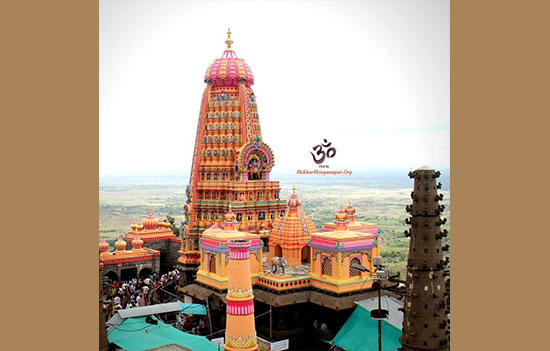 Shikhar Shinganapur Temple (Credit: Shikhar Shingnapur Devsthan Trust)
Shikhar Shinganapur Temple (Credit: Shikhar Shingnapur Devsthan Trust)
The Yadavs have a great influence on Deccan especially Maharashtra.
They were great patron of arts. Sangeet Ratnakar (by Sarangdev),
Siddhant-Shiromani (Changdev), Suktimuktavali
(Jalhana), Chaturvargachintamani
(Hemadri- a commentary on Dharmshastra), Muktaphal
& Harilila (Bopdeva), Rukminiswywamvar
(Narendra), Lilacharita (Mhaimbhat) were
some of main works in literature during Yadava reign. Dnyaneshwari,
Marathi commentary on Bhagwadgeeta by Shri Dnyandev was written in the same
period.
The concept of Pandharpur wari also started in the later part of Yadava rule. Hemadri, the prime minister of Yadavas introduced Modi font
(script in which Marathi was written till early 20th century).
The Yadavas were Shivabhakts and some of
the magnificent temples like Bhimashankar, Aundha Nagnath, Gondeshwar (Sinnar),
as well as Pandharpur temple were built during their rule.
The continued patronage & existence of Jain temples like Bhogoli, Hatkanagale, Pattankodoli even after regime change (From Sendrakas to Chalukyas to Shilhara to Yadava) or Ambernath, Walkeshwar, Khidrapur (Shilhar to Yadava) shows the tolerance of Indian kings and how hollow & baseless the claim ‘Hindu kings destroying each other’s temple’ of Eaton et al.
Part two
will be about Rashtrakutas and Chalukyas. To read part 2
To read all
articles by author
To
read all articles on Maratha History
To read all
articles on Indian History
References
1. History of
Shilahar dynasty & their inscriptions by Prof. Vasudev V. Mirashi (VSM,
Nagpur-1974)
2. History &
Culture of the Indian People, Volume V by K.M. Munshi and R C Mujumdar
(Bharatiya Vidya Bhavan, 1966)
3. A Comprehensive
History of India, Part 4, Volume1 by R.S. Sharma (Indian History Congress,
1987).
4. A Comprehensive
History of India, Volume-5 by M. Habib/K.A. Nizami (Indian History Congress,
1970).
5. Kaifiyat of
Jadhav Family by Gopal Dalvi (Induprakash/Maratha-Mitra, 1912).
6. Epigraphia
Indica, Volume 25 Inscription-21, Pg199-225, Volume 13 Inscription-17, Pg 198-206